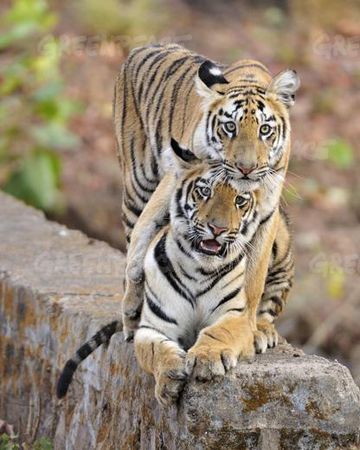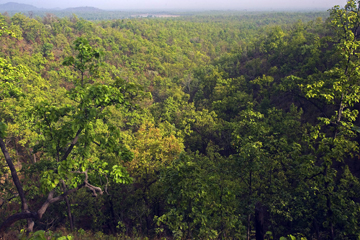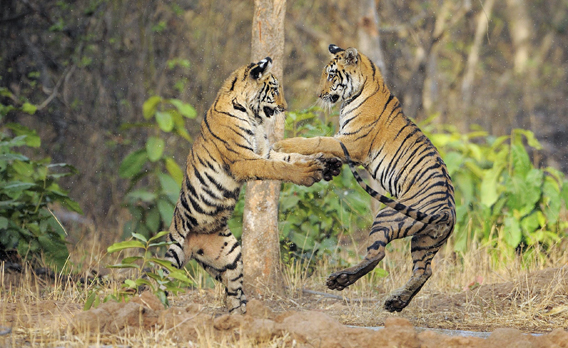
Surface coal mining in Bihar, India. Around 70-80 percent of India’s power is currently provided by coal.
Burning coal fuels climate change, causes acid rain, and spreads toxic pollutants into the environment, but now a new Greenpeace report warns that coal may also imperil the world’s biggest feline: the tiger. Home to world’s largest population of tigers—in this case the Bengal subspecies (Panthera tigris tigris)—India is also the world’s third largest coal producer. The country’s rapacious pursuit of coal—it has nearly doubled production since 2007—has pushed the industry into tiger territory, threatening to destroy forests and fragment the tiger’s already threatened population.
“Unfortunately for the tiger, its largest contiguous habitat—Central India—is also where most of India’s coal lies,” Ashish Fernandes, author of the report, told mongabay.com.
India is one of the bright spots in the global effort to save the tiger from extinction. The country now holds around 1,700 tigers, over half of the world’s population of wild tigers. Although India’s tiger population is generally considered to be in decline, there have been some local population increases giving hope that the country can turn around the situation. Yet the tiger still faces poaching and habitat loss, the latter which is likely to be exacerbated by open pit mining for coal.
 Bengal tigers in India’s Tadoba region. India holds more tigers than any other country in the world. Photo courtesy of Greenpeace. |
“Several of India’s largest coalfields (such as Singrauli and Talcher) include forest areas adjoining Tiger Reserves, and where tigers are found. Coal mines are already eating into these areas, and with the ongoing expansion, this will worsen,” Fernandes says.
The Bengal tiger, which is considered Endangered by the IUCN Red List, is the undisputed king in these forests, which in some cases also sports populations of leopard (Panthera pardus), Near Threatened; Asian elephant (Elephas maximus), Endangered; sloth bear, (Melursus ursinus), Vulnerable; sambar (Rusa unicolor), Vulnerable; and other non-threatened deer and antelope species.
Analyzing 13 Central Indian coal mines, in various stages of exploitation, the report finds that full open pit mining in these areas would destroy over a million hectares of forest. According to official data, 18 percent of these forests are known to be used by tigers, 27 percent by leopards, and 5.5 percent by elephants. In all, eight of India’s renowned Tiger Reserves will be impacted, potentially harming around 230 tigers or 13 percent of India’s total tiger population.
 Photo courtesy of Greenpeace. |
“India’s Protected Areas/Tiger Reserves are small by global standards, with few larger than 500 square kilometers. As such, if isolated, their tiger populations are not viable in the long term,” Fernandes explains. “Tigers, males in particular, roam large areas in search of mates, and this ensures genetic vibrancy. As young tigers mature, they also need to establish their own territories, or face conflict with dominant males. Corridors help aid this dispersal and ensure a healthy gene flow between different ‘source’ tiger populations.”
India is a signatory of an ambitious conservation plan to double wild tiger populations worldwide by 2022, a plan which was endorsed by all 13 tiger countries in 2010. Worldwide, tigers have been decimated by habitat loss, prey depletion, and hunting, now largely to feed the Chinese medicine trade. The great cats have been left with about 7 percent of their historical range, and already three subspecies have vanished for good.
Coal mining in Central India also raises broader issues beyond wildlife and the effort to save the tiger. India’s natural forests continue to vanish. According to the Food and Agriculture Organization (FAO), around 19 percent of India is covered in natural forests, excluding monoculture plantations, and many of the remaining forests are degraded and fragmented. Last year the federal government announced a $10.14 billion (460 billion rupees) plan to expand its forests by five million hectares (over 12 million acres), while improving forests quality on another five million hectares. But the state of India’s forests remains complex and generally one of ongoing decline.
“India is losing natural forests at a rate of between 1.5 to 2.7% a year—alarming when you consider that the country has already lost 70% of its native forest cover,” says Fernandes. “Plantations however are growing—usually with fast growing monoculture species such as acacia. Plantations are no substitute for natural forests. The Indian government is using its aggressive plantation program to hide the ongoing destruction of natural forest—primarily for mining, dams and other large infrastructure projects.”
The loss of these forest will also impact the livelihoods of local communities, according to the report.
“India’s forest communities rely on a variety of forest produce for their own domestic use and for sale in local markets—honey, fruits, flowers, seeds, bamboo products, firewood. In many areas, the forest doesn’t just supplement other incomes, it is the main income,” Fernandes says, adding that forest loss in one area may result in ongoing pressure elsewhere. “When a forest is lost to a coal mine, the community that depended on it is forced to migrate in search of other options—usually casual labour, if available, or move closer to another forest area, increasing the human pressure on remnant forests.”
  Photos courtesy of Greenpeace. |
India’s fixation on coal is also having climatic impacts. Today, India is the world’s third largest emitter of greenhouse gases largely due to its dependence on coal. Last year, India’s carbon emissions jumped 6 percent, while emissions fell around 2 percent in the U.S. and around 3 percent in Europe. At climate negotiations India has argued, rightly, that from a historical perspective its responsibility is far lower than that of Europe’s or the U.S.’s In addition, India’s emissions per person still remains far below those of wealthier countries. Still, its hard to see how global greenhouse gas emissions will begin dropping soon—as scientists say it must to avoid dangerous climate change—if both India and China, whose emissions rose 9 percent last year, refuse to look at energy sources beyond coal in the near-term.
In its report, Greenpeace argues that it’s time for India to make a rapid transition to wind and solar energy.
“In some parts of India, wind energy is already on par with grid power,” Fernandes says.
Such a transition would also relieve the nation’s dependence on a grid system full of problems, since solar and wind can provide power without connecting to the grid. This week India made international news when its grid failed twice, leaving 700 million people without power.
“For thousands of [remote] villages, the cost per unit of most forms of renewable energy at current rates is considerably less than the cost of grid-connected electricity,” reads the report.
Despite the climate, social, and wildlife hazards of India’s coal boom, the country has no plans to slow coal production. According to the report, the government plans to increase domestic coal production 41 percent by 2017 from last year’s levels.
“The Indian government is wary of reducing its own coal use when it doesn’t see these countries (the U.S., Canada, etc.) fulfilling their greater responsibility,” Fernandes explains, but describes this strategy as “myopic.”
“This game has only losers—there are sound domestic reasons why India needs to get off coal. The financial, social and environmental costs of coal on the Indian people are too high,” she adds.
 Bengal tigers in India’s Tadoba region. India holds more tigers than any other country in the world. Photo courtesy of Greenpeace. |
Related articles
Nearly 50 tigers die in India in last six months
(06/18/2012) Since January 1st, 48 Bengal tigers (Panthera tigris tigris) have been found dead in India, which has the world’s largest population of tigers. According to India’s National Tiger Conservation Authority (NTCA), 19 of those deaths have been confirmed to be at the hands of poachers, but that number could become even higher. In order to combat a surge in tiger poaching, the Indian state of Maharashtra has recently granted legal immunity to any forest ranger who shoots a poacher.
Rangers now allowed to shoot tiger poachers on sight in Indian state
(05/25/2012) In the wake of a surge in tiger poaching, the state government of Maharashtra, India will no longer consider the shooting of wildlife poachers by forest rangers a crime, reports the Associated Press.
Camera traps discover tigers, elephants in “empty” forest park

(04/16/2012) Although it’s named Namdapha Tiger Reserve, conservationists had long feared that tigers, along with most other big mammals, were gone from the park in northeast India. However, an extensive camera trap survey has photographed not only Bengal tigers (Panthera tigris tigris), but also Asian elephants (Elephas maximus), which were also thought extirpated from the park. Once dubbed an “empty forest” due to poaching, the new survey shows that Namdapha still has massive conservation potential.
India targets forests for destruction, industrial development

(02/28/2012) In a bid to fast-track industrial projects, India’s Prime Minister’s Office (PMO) is opening up 25 percent of forests that were previously listed as “no-go” areas, reports the Hindustan Times. The designation will allow between 30 and 50 new industrial projects to go ahead rapidly, including road construction and coal mining. Reportedly the changes came after industry representatives met with the Prime Minister’s Office, headed by Manmohan Singh, to complain that projects were being held up by environmental regulations, in some cases taking six years for approval.
India says tiger numbers up, but expert raises doubts
(03/28/2011) According to the Indian government tigers have gone up by 225 individuals in the past four years, from 1,411 big cats to 1,636 today, a 16% increase. The new census, however, also counts 70 tigers in the Sundarbans, which were not included in the past census, making the new grand total 1,706 Bengal tigers (Panthera tigris tigris). But don’t raise champagne glasses just yet, renowned conservationist with Wildlife Conservation Society (WCS) and tiger expert, Dr. Ullas Karanth, sees serious issues with the new tally, including a methodology that “has not been made public in a scientifically acceptable manner” and depends on a big count every few years instead of comprehensive and reliable year-by-year tracking methods. Despite such doubts, the news has generally been greeted with accolades.
India government: forest target ‘unrealistic’
(03/20/2011) Not long ago much of India was covered in vast and varied forests. Today just over one-fifth (21%) of the nation remains under forest cover, according to the Food and Agriculture Organization (FAO) but an ambitious plan hopes to bring the forest cover percentage to 33%, or one third of the country. However that goal has been dubbed ‘unrealistic’ by India’s influential Minister for Environment and Forests, Jairam Ramesh, as reported by The Hindu.
India commits $10 billion to expand forests
(02/25/2011) The Indian government has approved a bold plan to expand and improve the quality of its forests as a part of the nation’s National Action Plan on Climate Change. The reforestation plan, dubbed the National Mission for a Green India (NMGI), will expand forests by five million hectares (over 12 million acres), while improving forests quality on another five million hectares for $10.14 billion (460 billion rupees).
Parks key to saving India’s great mammals from extinction

(02/24/2011) Krithi Karanth grew up amid India’s great mammals—literally. Daughter of conservationist and scientist Dr. Ullas Karanth, she tells mongabay.com that she saw her first wild tigers and leopard at the age of two. Yet, the India Krithi Karanth grew up in may be gone in a century, according to a massive new study by Karanth which looked at the likelihood of extinction for 25 of India’s mammals, including well-known favorites like Bengal tigers and Asian elephants, along with lesser known mammals (at least outside of India) such as the nilgai and the gaur. The study found that given habitat loss over the past century, extinction stalked seven of India’s mammals especially: Asiatic lions, Bengal tigers, wild dogs (also known as dholes), swamp deer, wild buffalo, Nilgiri Tahr, and the gaur. However, increasing support of protected areas and innovative conservation programs outside of parks would be key to saving India’s wildlife in the 21st Century.